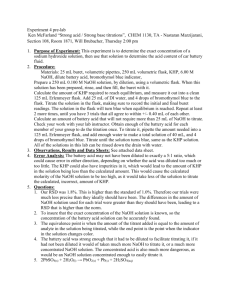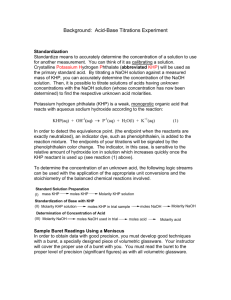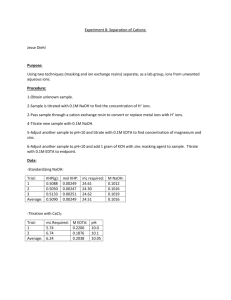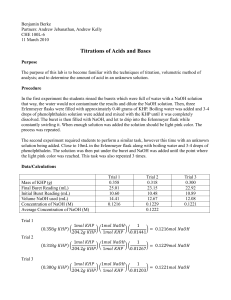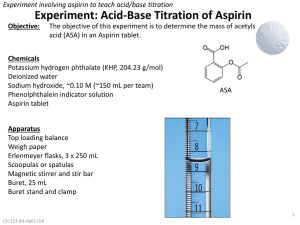Chem 225 lab
advertisement
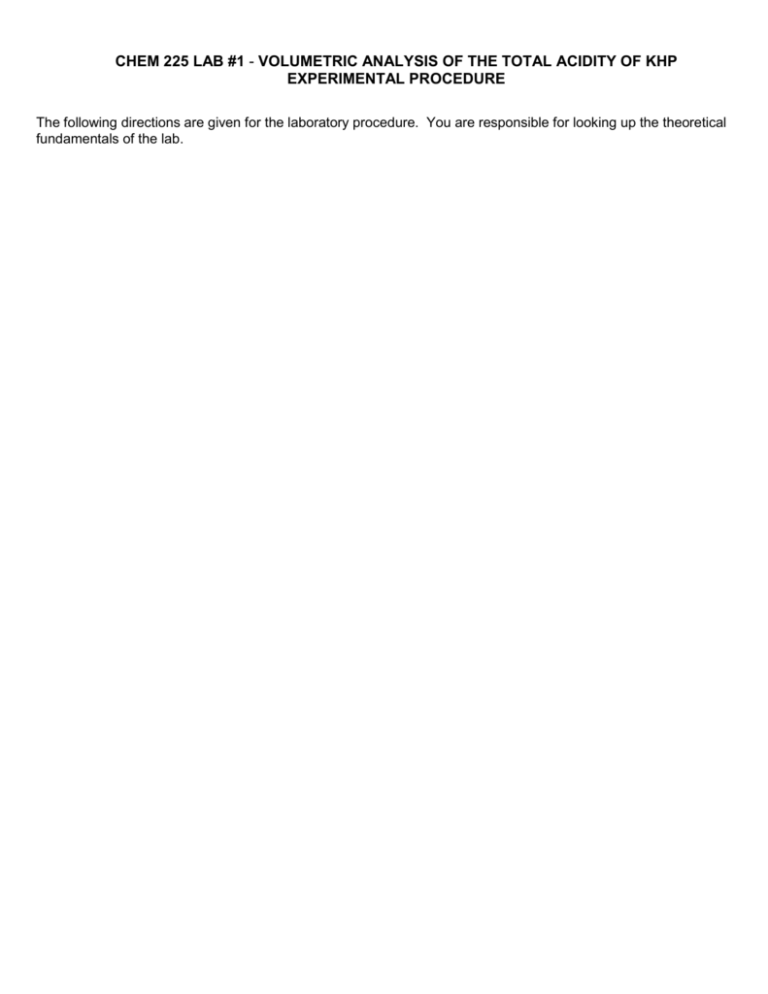
CHEM 225 LAB #1 - VOLUMETRIC ANALYSIS OF THE TOTAL ACIDITY OF KHP EXPERIMENTAL PROCEDURE The following directions are given for the laboratory procedure. You are responsible for looking up the theoretical fundamentals of the lab. Preparation for Week 1 of this Lab: 1. Read and sign the chemistry laboratory rules sheet. 2. Check in 2 general chemistry drawers, an analytical chem drawer and an analytical chem cabinet 3. Check your buret and buret stand Neither the stopcock nor the buret stand should be loose. Fill your buret with water a few times to clean it and then leave it full with water covered with the buret cap. ALL WATER used should be from the plastic jugs and NOT the sink!!! 4. Check your desiccator (used to keep your unknown samples DRY) There should be a good grease seal on the lid. Be careful when using the lid. Don’t place it face down on the desktop – for one, it gets grease on the bench and more importantly it destroys the seal. Always replace the lid as soon as possible. 5. Clean three weighing bottles (with water). Put all three weighing bottles in a large beaker with their tops off, cover with a ribbed watch glass, and put in an oven to dry. Make sure that you put your name on the outside of the beaker with a magic marker or a pencil. Before leaving for the day, store your dried weighing bottles in a desiccator. 6. Check the electronic balances Make sure you understand how to use them (including zeroing). Practice placing samples on the pan using Kimwipes. THE OILS FROM YOUR FINGERS WILL CHANGE THE WEIGHT! 7. Clean 4 glass frits. Set up one or more filtering apparatuses (will be demonstrated). If your frit is a little RED, rinse a little concentrated HCl through it. HOLD THE FRIT DOWN ON THE HOLDER UNTIL A VACUUM EXISTS! Rinse well with distilled water. HOLD THE FRIT WITH YOUR FINGERS AND THEN RELEASE THE PRESSURE! Place the frits in a covered beaker (ribbed watch glass) and put them in the microwave for 4 minutes and 2 minute intervals. Label the beaker with your name! a. The frits need to be weighed to constant weight. 1. Heat for 4 minutes in the microwave. 2.. Cool for 15 minutes to room temperature in the desiccator. 3. After cool, weigh on the electronic balances. The electronic balances should always remain on – they weigh to 0.0001 g (0.1 mg). 4. After weighing, heat in the microwave for 2 minutes. 5. Cool for 15 minutes to room temperature in the desiccator. 6. Reweigh on the same balance . If the two weights differ by more than +/- 0.4 mg (+/- 0.0004 g) then repeat heating, cooling, and weighing. 8. Put two of your clean, dry weighing bottles on the benchtop in the area where the knowns/unknowns are distributed. Mark the outside of the weighing bottle using a pencil or magic marker. Place the bottles on a piece of paper with your name on it. You will receive 5 grams of known potassium acid phthalate (KHP) and 10 grams of unknown KHP. You will need to dry these samples in the oven at 1100C for 2 hours before coming to lab next week. Cool in a desiccator and store until you come to lab. REMEMBER to record the % purity of the KNOWN in your lab notebook. !! Before leaving for the day, store your remaining dried weighing bottle in a desiccator!! Week 1 of VOLUMETRIC ANALYSIS OF THE TOTAL ACIDITY OF KHP 1. Prepare 0.1M Sodium Hydroxide (NaOH) a. Use two large glass containers (beakers, Erlenmeyer flasks or florence flasks) to boil 1100 mL of water. Boil for five minutes, cover with a watch glass, and allow to cool. While the water is still warm (about 40C), use a plastic 1000 mL graduated cylinder to transfer 1000 mL to a one liter screw-cap polyethylene bottle (this polyethylene bottle must be flexible - see the Instructor or a Lab Assistant if your plastic bottle is rigid). Prepare a 0.1M NaOH solution from the 50% stock solution of NaOH. NOTE: The 50% solution of NaOH has already been prepared by mixing 250 grams of NaOH with 250 mL water. This solution must be CLEAR (any solid white precipitate should have settled to the bottom). DO NOT AGITATE OR PICK UP THIS CONTAINER!!! CAREFULLY unscrew the lid without agitating the solution. Use the plastic disposable pipet next to the container to transfer ? mL from the TOP PORTION of the solution to a 10 mL graduated cylinder. You need to determine the number of mL to use. b. Add the concentrated NaOH solution to the 1000 mL of cooled, boiled water. Squeeze the polyethylene bottle to force any excess air out of the bottle, and tightly secure the screw-cap lid (always store the bottle like this). MIX THE SOLUTION WELL !!!! 2. Weigh out known samples a. Weigh out four 0.75 gram samples (0.1 mg) of KNOWN KHP into 250 mL Erlenmeyer flasks (make sure the flasks are labeled). b. Weigh out your sample by difference from a weighing bottle 1. To weigh by difference, put weighing bottle (with lid) with your sample on the pan of the balance and close the balance door. 2. Rezero. 3. Take the bottle off of pan (take lid off) and tap some sample into a beaker using Kimwipes. 4. Put lid back on and weigh again. The NEGATIVE number will be the sample size you put in the beaker. NEVER PUT SAMPLE FROM THE BEAKER BACK INTO THE WEIGHING BOTTLE! 5. REMEMBER – temperature affects weight so make sure it is at room temp when weighed. 3. Practice with the buret a. Forming drops and half-drops b. Using the meniscus card reader c. Becoming familiar with the position of the stopcock Week 2 of VOLUMETRIC ANALYSIS OF THE TOTAL ACIDITY OF KHP 1. Standardization of Sodium Hydroxide SAVE YOUR LEFTOVER NaOH FOR THE 3rd LAB !!!!!! a. Take your four 0.75 gram samples (0.1 mg) of KNOWN KHP(from last week) and dissolve each in 50 mL of distilled water. b. Add two drops of phenolphthalein indicator. Always swirl your sample as you tirate. NOTE: Check your data as you are proceeding, mL/g should be constant for each trial. Use this ratio to: 1. Predict X, the volume for the next titration: mL1 X --------= -------g1 g2 X is the predicted volume for the next titration 2. Compare all the ratios as you proceed. If the ratios are widely different, quick weigh out another sample and titrate it. This will increase your accuracy/precision. c. Titrate with your 0.1 M sodium hydroxide (remember to rinse out your buret with NaOH first, and, when starting a titration, put enough in since filling the buret twice for a titration increases the error) until a FAINT PINK COLOR persists for 30 seconds (exposure to air causes this end-point to gradually fade back to a colorless solution). Fractional drops should be added as the end-point is being approached. Try to obtain in the same FAINT PINK COLOR in all the trials (this is difficult because the end-point fades, making direct comparison unreliable). NOTE: CONTINUE AS SOON AS POSSIBLE WITH THE UNKNOWNS!! NaOH is unstable when exposed to the air. KEEP TIGHTLY CAPPED! It is possible to do all the titrations of this lab in one day. 2. Unknown KHP Sample a. Perform a preliminary titration on the unknown. 1. Weigh out approximately one gram of the unknown (dried or undried) into a 250 mL flask 2. Add 50 mL of water and two drops of phenolphthalein. 3. Titrate to a faint pink color using your standardized 0.1??? M NaOH. a. Use this trial to adjust your sample size so the titration will require 20 to 30 mL of the standardized 0.1??? M NaOH (the maximum sample size should not exceed 2 grams). 4. Using the adjusted sample size, weigh out four samples (0.1 mg) of the UNKNOWN KHP into 250 mL erlenmeyer flasks (make sure the flasks are labeled). Weigh out your samples by difference from a weighing bottle. 3. Titrate the unknown samples a. Titrate these samples using the same procedure that was used for the knowns. Remember to use the ratio that you determined above. b. When finished, drain the NaOH out of your buret and rinse it with water (including the tip). Always store your buret with water in it. SAVE YOUR NaOH FOR THE POLYPROTIC ACID LAB !!!!!! Put out a clean and dry weighing bottle for next week’s lab CALCULATIONS TO BE COMPLETED AT THE END OF THE LAB 1. Calculate the average molarity of your NaOH, the Standard Deviation (SD), and the Relative SD 2. Calculate the average % KHP in your unknown, the SD and the Relative SD. HINTS FOR CALCULATIONS for VOLUMETRIC ANALYSIS OF THE TOTAL ACIDITY OF KHP : 1. Flow Chart KNOWN KHP + NaOH NaKP + HPgknown moleKHP UNKNOWN HP- + OH- P2- MNaOH This is called standardization !! Determining an exact Molarity After preparing approximately moleOH + OH- P2- moles OH- moleKHP x 100 % KHP gsample + H2O Lused_to_titrate Lused_to_titrate * MNaOH gKHP H2O + H2O KHP Lab – Things to Think About 1. Phenolphthalein indicator - basic transition range a. Color changes from colorless (in acid) to light pink (in base) 2. Dilute NaOH in D.I. water a. Boil the water; cool water in sink full of cold water 3. NaOH will react with carbon dioxide a. CO2 + 2OHCO32- + H2O b. 2 hydroxides lost to form one carbonate ion 4. Problem: you will be using phenolphthalein which has an indicator basic transition range a. CO32- + H3O+ HCO3- + H2O b. 1 Carbonate ion reacts with one hydronium ion 5. Points 2,3, and 4 lead to a concentration error (systematic error) for NaOH 6. Store NaOH in polyethylene bottles because NaOH will react with glass 7. Always squeeze the air out of your bottle (and always cap it) so that the NaOH will not react with CO2 a. CO2 + 2NaOH Na2CO3(s) + H2O b. Solid sodium carbonate will be in the bottom of the 50% NaOH solution so be sure to decant from the top of the solution 8. Why are your stopcocks on your burets Teflon????? 9. How many moles of OH- react with one mole of KHP?
